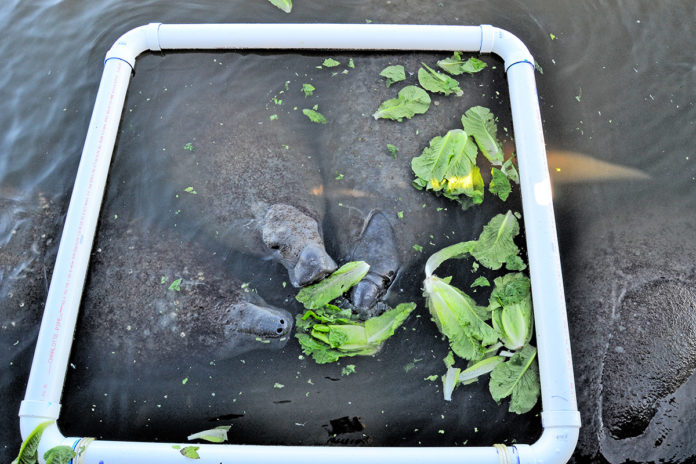
On Jan. 13, a media call to address an unusual mortality event (UME) affecting starving Florida manatees reported that emergency feeding stations set up near the Florida Power and Light plant in Cape Canaveral had yet to see success in nearly a month of delivering lettuce to starving animals.
Even so, FWC’s Imperiled Species Management Section Leader Ron Mezich spoke optimistically, saying that the manatees’ failure to recognize lettuce as a food source was not unexpected and was in line with rescued animals’ tendency to take a few days or even weeks to recognize the plant as food.
Within a week, Mezich’s faith was rewarded.
“We’ve seen 35 manatees at the feeding area on Jan. 20 eating lettuce, and 25 today,” said Mezich in a second media call on Jan. 21. “We’ve offered about 450 pounds of produce, which has been largely consumed.”
Mezich said the group had been waiting for some sort of trigger to begin the feeding process, but wasn’t exactly sure what that trigger would be. On the day feeding was first observed, the team had already been preparing acoustic equipment to play sounds of manatees foraging near the lettuce in an effort to jump-start the process.
“We think it’s significant,” said Mezich. “A couple animals decided to try it, and once they started eating, it was a trigger for the others.”
The team reports that most animals feeding on the lettuce appear to be in good shape, though they have spotted some underweight animals. Aerial surveys of the general area have shown several hundred manatees nearby that may eventually make their way to the feeding area.
Feeding manatees and other marine mammals is illegal for the public, and several media members on the call asked Mezich how the team plans to prevent the manatees at the feeding site from associating humans with, and depending on them for, nutrition.
“We’ve put up barriers to prevent them from seeing the humans providing food,” said Mezich. “We also try to avoid boats in the area so they don’t associate the food with boats, and we don’t man the site at night.”
The feeding site currently uses romaine and butter lettuce as food, both of which have been consumed by the hungry sea cows. Mezich says the group is unsure exactly how long they will continue the feeding trials, but that he fully expects the manatees to naturally disperse as warmer waters permit foraging in wider regions. Plans for other emergency feeding stations are also in discussion, but have not been finalized.
More information about the UME response is at myfwc.com/research/manatee/rescue-mortality-response/ume/.


























